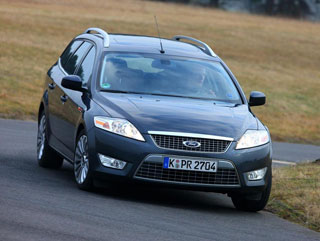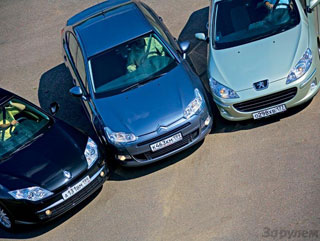PEUGEOT 407 test drive since 2004 sedan
Turn to me in front
 First, dynamic family sedans were built on Peugeot. Now all the same cars are being made there, only now they look like a sports compartment: Peugeot 407.
First, dynamic family sedans were built on Peugeot. Now all the same cars are being made there, only now they look like a sports compartment: Peugeot 407. It is enough to look at the advertising icon of the new middle class sedan from Peugeot to understand the basis of the style of this machine. Several spots, three of which indicate slanting headlights and a huge grille - the mouth of the air intake. Something in the style of Ferrari. However, in this case, Pininfarina has nothing to do with it: the 407th was made by French designers, although with the frank use of Italian archetypes coupe. A huge hood and a short salon with sloping glasses and a short ledge of the trunk unequivocally hint that Peugeot is tired of the reputation of the French Mercedes. What was not difficult to guess both by films from Luke Besson and in advertising slogans. The departure from the classical style of the 406th is a logical change in the fashion concept: now healthy aggressiveness is considered the norm in all classes. And about autocadonism - the pleasure of any aspects of the possession of the machine - unless they say the finished originals.

Fashionable sports traditions: light scales, chrome rims and even an indicator of oil temperature (in the lower right corner)!
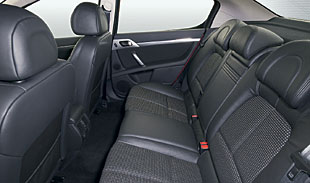
The rear seat passengers also have nothing to complain about
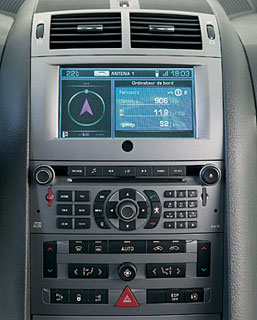 OPTICAL ILLUSION. The admiration of a dimensionless hood grew in anticipation of tightness in the cabin. But inside the 407th, a pleasant disappointment awaits us-this is still not a cockpit, it is a salon. In height of 407th, almost the same as the 607th, and even slightly exceeds Volvo S80-hence the size. PEUGEOT 407 is made on the same platform as the Citroen C5, which at the known moment became one of the leaders of its class in terms of the passenger compartment. But here the base is also increased by 25 mm. So the style is style, and the 407th is protected by the family values \u200b\u200bof the United Europe. That's just the volume of the trunk - 407 liters - for a car with a length of more than 4.5 m not at all an achievement. If this is not enough, you will have to fold the rear seat, and even on cheapest modifications it can fold in parts.
OPTICAL ILLUSION. The admiration of a dimensionless hood grew in anticipation of tightness in the cabin. But inside the 407th, a pleasant disappointment awaits us-this is still not a cockpit, it is a salon. In height of 407th, almost the same as the 607th, and even slightly exceeds Volvo S80-hence the size. PEUGEOT 407 is made on the same platform as the Citroen C5, which at the known moment became one of the leaders of its class in terms of the passenger compartment. But here the base is also increased by 25 mm. So the style is style, and the 407th is protected by the family values \u200b\u200bof the United Europe. That's just the volume of the trunk - 407 liters - for a car with a length of more than 4.5 m not at all an achievement. If this is not enough, you will have to fold the rear seat, and even on cheapest modifications it can fold in parts. Powerful forms of chairs demonstrate that Peugeot is not as alien to the classic as it might have seemed in the appearance of the 407th. The fact that traditions are still in fashion also resembles a shield of devices with chrome rims of round scales. The console panel is also not shocking extravagance. Although compared with the 406th progress is obvious.
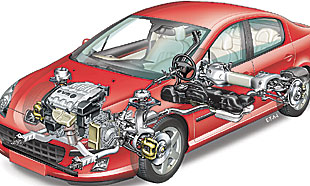
The front suspension is now double -leaved. The back remained the same in accordance with the scheme, but combined on a fashionable aluminum cross member
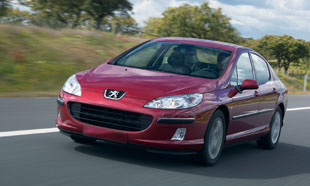 Six and six. The range of modifications of the 407th is very extensive: four gasoline engines (from 1.7 to 2.9 liters) and two turbodiesels (1.6 and 2.0). The latter are very popular in France and Europe, but they are unlikely to be well sold with us. The top version with an almost three-liter V-shaped six is \u200b\u200bready to accelerate to hundreds in less than 10 seconds. This engine has been put on different models of all three French manufacturers for five years, but for the 407th he received a system of changed gas distribution phases. The box is generally new, six -speed, automatic and at the same time Japanese - by order of Peugeot makes it Aisin. Naturally, this machine has the opportunity to switch programs manually, and besides, it adapts to the driving style. The first feature is implemented quite well: the box holds the transfer on even at maximum speeds, without jumping up, and the commands for switching are performed quite quickly. It was not possible to notice adaptability: even after a series of intensive accelerations, the box still tries to accustom the driver to the economical style of movement and switches up too quickly. True, the engine return is enough in almost any range.
Six and six. The range of modifications of the 407th is very extensive: four gasoline engines (from 1.7 to 2.9 liters) and two turbodiesels (1.6 and 2.0). The latter are very popular in France and Europe, but they are unlikely to be well sold with us. The top version with an almost three-liter V-shaped six is \u200b\u200bready to accelerate to hundreds in less than 10 seconds. This engine has been put on different models of all three French manufacturers for five years, but for the 407th he received a system of changed gas distribution phases. The box is generally new, six -speed, automatic and at the same time Japanese - by order of Peugeot makes it Aisin. Naturally, this machine has the opportunity to switch programs manually, and besides, it adapts to the driving style. The first feature is implemented quite well: the box holds the transfer on even at maximum speeds, without jumping up, and the commands for switching are performed quite quickly. It was not possible to notice adaptability: even after a series of intensive accelerations, the box still tries to accustom the driver to the economical style of movement and switches up too quickly. True, the engine return is enough in almost any range. 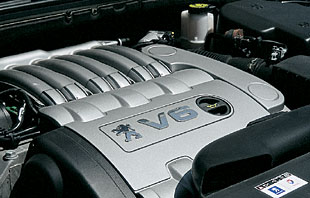
And the well -known V6 received a system for changing the phases of gas distribution
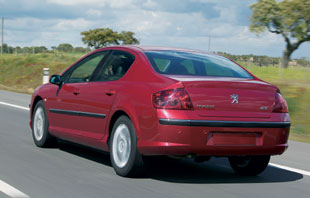 In terms of controllability and stability, as expected, the car became a worthy heiress of the 406th. The smoothness of the course, it seems, has also increased, although this contradicts the image of a four -door compartment. ESP is included in the package of all options, so the car simply will not allow to go beyond the limits of opportunities. On the V6 there is also an adaptive suspension with the individual setting of each shock absorber. It works mainly for comfort: after all, if at any second you can return to hard (and means safe) settings, you can do some of the nine available levels and softer.
In terms of controllability and stability, as expected, the car became a worthy heiress of the 406th. The smoothness of the course, it seems, has also increased, although this contradicts the image of a four -door compartment. ESP is included in the package of all options, so the car simply will not allow to go beyond the limits of opportunities. On the V6 there is also an adaptive suspension with the individual setting of each shock absorber. It works mainly for comfort: after all, if at any second you can return to hard (and means safe) settings, you can do some of the nine available levels and softer. Peugeot does not use the hydropneumatics of the fraternal Citroen, in terms of pendants, they are united only by what shock absorbers they do themselves. For the 407th, new units have been developed. The rear multi -link is collected on a rather compact aluminum box. Ahead of the two -leaf took place MacPherson. For the compartment, this remaining almost unsurpassed scheme is a very suitable option.
Subtle setting. The consequences of reducing the working volume and power compared to V6 on versions with engines of 2.2 and 2.0 liters are quite predictable and not at all tragic. However, cars differ not only in motors. In the struggle for the perfection of each individual version of Peugeot, I picked up five different transmissions to four motors. For example, if a ZF machine and a six -speed mechanics are selected for 2.2 liters, then with a two -liter, the hydromechanical transmission of their own development of Peugeot/Citroen and a five -speed manual is used.
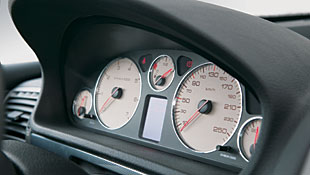 They also legibly approached the steering wheel amplifiers - there are three of them. And the difference is quite noticeable: the electronics on the three -liter version takes into account the angle of rotation of the steering wheel, the speed of the machine and a few more characteristics, and the electro -hydraulic amplifier is 2.0 and 2.2 l limited only by two mentioned parameters. What is first perceived as a sign of sports, but after meeting with the V6 amplifier it already seems too primitive. However, the third version of the amplifier, which is now placed on the most affordable versions (with a 1.7 liter gasoline engine and 1.6 liter diesel engines) is even easier: its effectiveness depends on engine speed.
They also legibly approached the steering wheel amplifiers - there are three of them. And the difference is quite noticeable: the electronics on the three -liter version takes into account the angle of rotation of the steering wheel, the speed of the machine and a few more characteristics, and the electro -hydraulic amplifier is 2.0 and 2.2 l limited only by two mentioned parameters. What is first perceived as a sign of sports, but after meeting with the V6 amplifier it already seems too primitive. However, the third version of the amplifier, which is now placed on the most affordable versions (with a 1.7 liter gasoline engine and 1.6 liter diesel engines) is even easier: its effectiveness depends on engine speed. Such intelligibility surprises no less than a new style. But after a day, a test drive we found that appearance annoys only from one point of view: when you admire the removable trunk. He looks faded. But the owners of the 407th one way or another will have a desire to often demonstrate precisely the rear of the car to everything that is moving.
Text Valery Chusov, photo Automobiles Peugeot
Peugeot 407 2.0 2.2 3.0
Engine gasoline four -cylinder gasoline four -cylinder gasoline V6
Working volume (cubic meter cm) 1997 2230 2946
Power (L.S. at rpm) 136 at 6000 160 at 5650 211 at 6000
Moment (Nm at rpm) 190 at 4100 217 at 3900 290 at 3750
Front front drive
Gearbox 5-st. Mechanical 6-st. Mechanical 6-st. Tiptronic automaton
Length/width/height (mm) 4676/1811/1447 4676/1811/1447 4676/1811/1455
Wheel base (mm) 2725
Asselled/complete mass (kg) 1415/1995 1480/2040 1585/2140
Maximum speed (km/h) 212 220 235
Acceleration to 100 km/h (c) 10.3 10.1 9.2
Fuel consumption (city/highway, l/100 km) 11.4/6.4 12.9/6.8 14.5/7.0
The price in Moscow from $ 26,400 from $ 30,450 from $ 37,950
Source: "Autopilot"
Video Crash tests Peugeot 407 since 2004
PEUGEOT 407 test drive since 2004
PEUGEOT 407 Crash Test since 2004
Krassh Test: Detailed Information34%
Driver and passengers
15%
Pedestrians
39%
Children-passengers







